Man of War: Charles V, Holy Roman Emperor
An article by Chad Arnow
 Politically-motivated marriages have been a mainstay of the nobility throughout the ages, as rulers and other powerful figures sought to solidify and increase their holdings. In Charles V, we see one of the peaks of this system in a monarch who ruled large portions of Europe and oversaw some of the explorations to the New World.
Politically-motivated marriages have been a mainstay of the nobility throughout the ages, as rulers and other powerful figures sought to solidify and increase their holdings. In Charles V, we see one of the peaks of this system in a monarch who ruled large portions of Europe and oversaw some of the explorations to the New World.
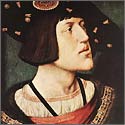
Portrait of Charles V, 1519-20, from the Museum of Fine Arts, Budapest
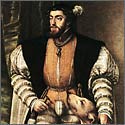
Charles V as painted
by Titian, 1533
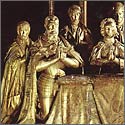
Tomb of Charles V from 1598. Escorial, Madrid
|
The future Charles V was born February 24th of 1500. His grandparents were Ferdinand II, King of Aragon, Isabella I, Queen of Castile, Mary of Burgundy and Maximilian I, Holy Roman Emperor. Charles was born in Ghent in family territories in Burgundy, and grew up influenced by the many cultures from which he descended. He was said to have been able to speak at least a little French, Dutch, German, Spanish, and Italian throughout the course of his life. Early in his life, he was tutored by the future Pope Adrian VI.
With the death of his father Philip the Handsome in late 1506, the very young Charles became titular ruler of the family's Burgundian territories, inherited through his grandmother Mary. In reality, the territories were under the rule of the appointed regent, his aunt, until 1515. Throughout his life, he expanded the Burgundian territories and strengthened their ties with the Holy Roman Empire.
With the death of his maternal grandfather, Ferdinand II, the teen-age Charles V became the first ruler of a united Spain, bringing together Aragon and Castile. This united kingdom included the old kingdom of Navarre, bordering the western Pyrenees Mountains, the city of Granada, Naples, the two largest islands in the Mediterranean Sea, Sicily and Sardinia, and all the Castilian territories in the New World. Though considered by many to be a foreigner, Charles spent most of his life in Spain after his succession to the Spanish throne.
The death of Maximilian I in 1519 gave Charles control of the Habsburg lands, extending his rule into Austria. His lineage and holdings made him an obvious candidate to succeed Maximilian as Holy Roman Emperor. His main rival for the position was France's Francis I, who would conflict with Charles throughout his life. Charles prevailed and was elected in June of 1519, around six months after his grandfather's death. Francis and Charles would spend years in conflict over the sovereign rule of Burgundy (held by Francis), as well as territories in Italy. Charles eventually gained control of Milan, and conquered Rome. When not fighting France directly, Charles fought against the Ottoman Empire, a threat to his Habsburg holdings, which was known to ally itself with France.
Charles's lifetime saw the rise of Protestantism in Europe. Martin Luther's theses were written shortly before Charles was elected Holy Roman Emperor. Charles, as emperor, outlawed Protestantism, which led to conflict in his German lands. His capture of Rome kept Pope Clement VII from issuing an annulment to Henry VIII's marriage to Catherine of Aragon, Charles's aunt. This was one of the steps toward the eventual souring of Anglo-Spanish relations and towards the establishment of the Church of England.
In 1556 Charles V, bothered by ill health and gout, passed control of his Spanish and his Burgundian territories to his son Philip II. His German lands and the Holy Roman Empire were passed to his brother Ferdinand, who had been given increasing control over them as Charles had fought in Italy and against the Ottomans. Charles spent his late years at the monastery of Yuste in Extremadura, a western province of Spain. Though not in control any more, he did communicate with those in power and remained interested in the fate of the empire. Charles died September 21, 1558. His remains were permanently interred over two decades later at the newly-built Real Monasterio de San Lorenzo de El Escorial (Royal Monastery of Saint Lawrence of El Escorial). It was built by Philip II to house the remains of Spanish monarchs in its Royal Pantheon.
Equipment of Charles V
It should be no surprise that a monarch with Charles's wealth and political reach should have left behind a plethora of fine examples of arms and armour. Charles had access not only to the fine armourers of Germany like the Helmschmids and Konrad Seusenhofer (favorites of Maximilian I), but also to the finest Italian armourers, like the Negroli family. This trove includes many full harnesses, many other armour pieces, firearms, and other weapons with ties to Charles.
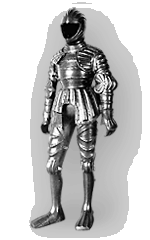
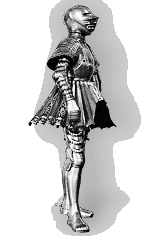
Two armours made for Charles V when he was a boy, circa 1512-14
|
The earliest surviving items attributed to Charles V are two "costume" harnesses made for him as a child by Innsbruck armourers, probably commissioned by Maximilian I. The earlier one was made in circa 1512 by H. (Hans?) Rabeiler, the later one between 1512 and 1514 by Konrad Seusenhofer. Both are of a design called puffed and slashed and were made to follow fashion popular at the time, especially among the Landsknechts employed by the Holy Roman Empire. The later harness, with its skirt (tonlet), features pierced bands of gilded silver over violet velvet. Both harnesses are housed in Kunsthistorisches Museum in Vienna.
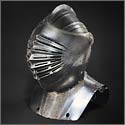
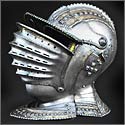
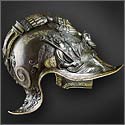
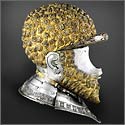
Four examples of the many surviving helmets belonging to Charles V:
Close helm, Kolman Helmschmid, circa 1536; "Diamond" burgonet, Kolman Helmschmid, before 1532; Parade burgonet,
Filippo and Francesco Negroli, 1545; Burgonet and buff in the shape of a bearded man, Filippo Negroli, 1533
|
In Madrid's Real Armería rests a harness for man and horse that dates to circa 1520. It is said to date from 1518 when Charles visited his Spanish kingdom for the first time. The harness is obviously built for the tournament, as it is reinforced on the left side to receive lance blows. The helm is of the shape we now call frog-mouthed. The harness for the man has etched bands of foliage surrounding plain ones on its larger plates. Some of these bands are echoed as decoration on the smaller pieces, as on the helm, gauntlets, and arms defenses. The bard (horse armour) features roped decorations and more etched bands, and removable lion's head decorations, as well as scenes depicting battles from the Bible. It is attributed to the Augsburg armourer Kolman Helmschmid.
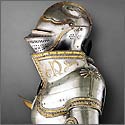
The "KD" Garniture
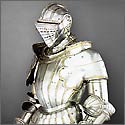
The "Hunt Tonlet"
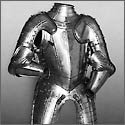
Three-quarter harness, dating 1543
|
Also in Madrid is a splendid garniture known as the "KD" garniture or the armour de bordes adiamantados (armour with diamond-studded borders). It is also attributed to Kolman Helmschmid and dates to circa 1525. It is a complete harness with pieces of exchange. Harnesses of this type could be used both in battle or in various forms of tournament combat by exchanging pieces and adding reinforcing defenses. This magnificent harness gets one of its names from the raised decorative bands that feature raised diamond shapes. The bands are surrounded by etched and gilt bands and by raised roped bands. The "KD" nomenclature comes from the ornately engraved initials on the haute piece of the left pauldron, said to signify Karolus Divus (Divine Charles), an imperial title. The harness can be worn in a variety of combinations and includes both and armet and a burgonet.
A third harness attributed to Kolman Helmschmid survives in the Real Armería. Known as the "Hunt Tonlet" it is a harness configured for combat on foot in a tournament. Its skirt-like tonlet has a removable band that features animals from the hunt on an etched and gilt background, giving it its name. The tonlet covers the upper part of the fully-enclosing, articulated breaches that now lacks its codpiece. All joints are completely protected by laminated plates, even the inside of the elbows and backs of the knees. As is typical of Helmschmid, the decoration, though ornate and complex with etched and gilt bands and roped sections, is broken up by expanses of plain steel, giving it a look that is elegant and functional.
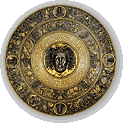
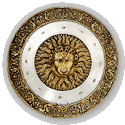
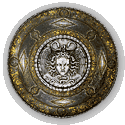
Parade shields: Medusa, circa 1550-55; Lion head, 1533; Medusa, 1541
|
Charles's dealings in Italy left us with fine examples of pieces crafted for him the by great Negroli family of Milan. The earliest of these is a parade helmet and shield dated to 1533. The helm's skull is embossed and gilded to look like curls of hair, with a laurel wreath encircling the brow. The bearded bevor, though similar, is not original. The decoration on its lower edge doesn't match the rest of the helm. The shield is embossed and gilt with a lion's head as its boss. Both burgonet and shield are signed and dated by Filippo Negroli and reside in the Real Armería.
Another helm of Charles V sculpted to appear as if with curly hair survives in Vienna, but was originally part of the "Palm-branch" armour whose pieces are in Madrid and in the Higgins Armory Museum in Worcester, Massachusetts.
Yet another harness survives in the Real Armería, this one by Desiderius Helmschmid, Kolman's son. This harness was assembled from armour pieces attributed to Charles V, many of them made by Desiderius in the 1530s. The pieces come from a combination of field and tournament harnesses.
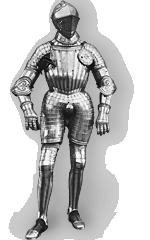
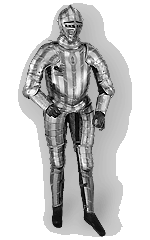
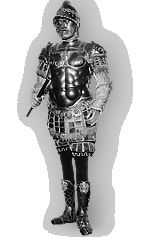
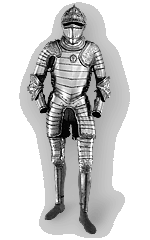
"De fajas espesas" field armour, 1558; Damascened garniture, circa 1550-53;
"Alia Romana" parade harness, 1546; Masks garniture, 1539
|
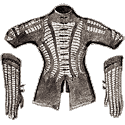
Mail and plate armour belonging to Charles V
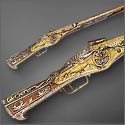
Saddle harquebus
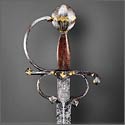
Italian sword,
circa 1546
|
Another Desiderius Helmschmid harness survives in Madrid, this one designed for the field. It was commissioned not long after the outbreak of conflict between Protestants of the Schmalkaldic League and Catholics, and was presumably used during those military efforts. This example, which features etched and gilt bands surrounded by roped borders, echoes some of the braided trim decoration popular in Spanish courtly dress at the time.
From 1541 dates another parade helmet and shield, also by the Negroli family. Resting in Vienna, it consists of an embossed and gilt burgonet with a pivoting visor in the form of a lion's mask. Given to Charles by his brother after Charles's successful African campaign, it features commemorations to heroes of ancient Rome's conquests in Africa. The round shield is also embossed and gilt and features the head of Medusa at its center.
A second Medusa-head parade shield of the Negrolis resides in Madrid. It is also damascened, embossed, etched and gilt. Its Medusa head appear to be slightly more complex. It also dates to 1541.
From 1545 survives an embossed parade burgonet, made by Filippo and Francesco Negroli. The comb is shaped as a bound Turk rising from a column, while it is also decorated with the allegorical figures of Fame and Victory. Similarly decorated burgonets reside in the Musée de l'Armée in Paris and in The Metropolitan Museum of Art, New York.
Dating to 1546 is one of Charles's more unique parade armours. Made by Bartolomeo Campi in Pesaro, it is known as the Alla Romana parade harness for its Romanesque look. This harness was a gift of the Duke of Urbino, Guidobaldo II, who hoped to curry favor with Charles V after his successes in Italy. It is inscribed with the armourer's name, Guidobaldo II's, and a note about how it was commissioned by the Duke and completed within two months. The harness's cuirass is muscled to represent classical Greek and Roman armour, and is accompanied by boots that imitate the thong lacing of Roman sandals, with embossed toes to complete the look.
In addition to these, there are other pieces of armour and armoured saddles belonging to Charles V that survive to this day. In the Kunsthistorisches Museum Vienna reside two burgonets attributed to Charles V. Both are by Desiderius Helmschmid and date from around 1540. Both feature roping, raised circles, and etched decorations. Also by Desiderius Helmschmid is a three-quarter harness dating from 1543.
While we have many examples of armour known to have belonged to Charles V, it is not often as easy to find weapons that can specifically be attributed to him. There are many surviving pieces that were given as gifts to Charles and even more records of such examples, but it's somewhat difficult to know how they were received or what was done with them.
There is a sword located in Madrid’s Real Armería that has matching ornamentation to the "damascened garniture" shown above. It is dated circa 1546 and came out of the Negroli workshop in Milan. While the attribution to Charles V is somewhat speculative, signs seem to indicate that the sword was commissioned with the armour.

Double-barreled wheellock gun of Emperor Charles V
|
Another surviving weapon is a pistol dated to 1540-45, made by Peter Pech of Munich. The barrel is etched and gilt, as are both lock mechanisms. The spirally-carved stock is of cherry wood. The barrels are stacked, and the double locks allow for two shots to be fired. This particular example resides in The Metropolitan Museum of Art, but several others attributed to Charles V reside in Madrid's Real Armería.
Conclusion
Charles V was a man of wealth and power whose influence reached from Western Europe, through Italy, the Mediterranean, and Spain and into the New World. As the first ruler of a united Spain and a backer of Spanish explorers, he played an important part in creating the world we know today. As Holy Roman Emperor he witnessed the beginnings of Protestant Reformation. Charles lived during a period of upheaval and change, and was an important figure in many events of the day. The arms and armour he left behind show evidence of both his great wealth and the awesome power he wielded.
About the Author
Chad Arnow is a classical musician from the greater Cincinnati area and has had an interest in military history for many years. Though his collecting tends to focus on European weapons and armour of the High Middle Ages, he enjoys swords, knives and armour from many eras.
Sources
Armeria del Palacio Real de Madrid [Armoury at the Royal Palace in Madrid], by Guillermo Quintana Lacaci
Arms and Armour of the Western World, by Bruno Thomas, Ortwin Gamber and Hans Schedelmann
Die Innsbrucker Plattnerkunst - Katalog
Katalog der Leibrüstkammer (Führer durch das Kunsthistorische Museum ; Nr. 13), by Vienna
Resplendence of the Spanish Monarchy: Renaissance Tapestries and Armor from the Patrimonio Nacional, by Antonio Dominguez Ortiz, Concha Herrero Carretero, Jose A. Godoy
Acknowledgements
Photograph copyrights include The Real Armería, Madrid; The Musée de l'Armée, Paris; The Metropolitan Museum of Art, New York; and The Kunsthistorisches Museum Vienna.
|
|

